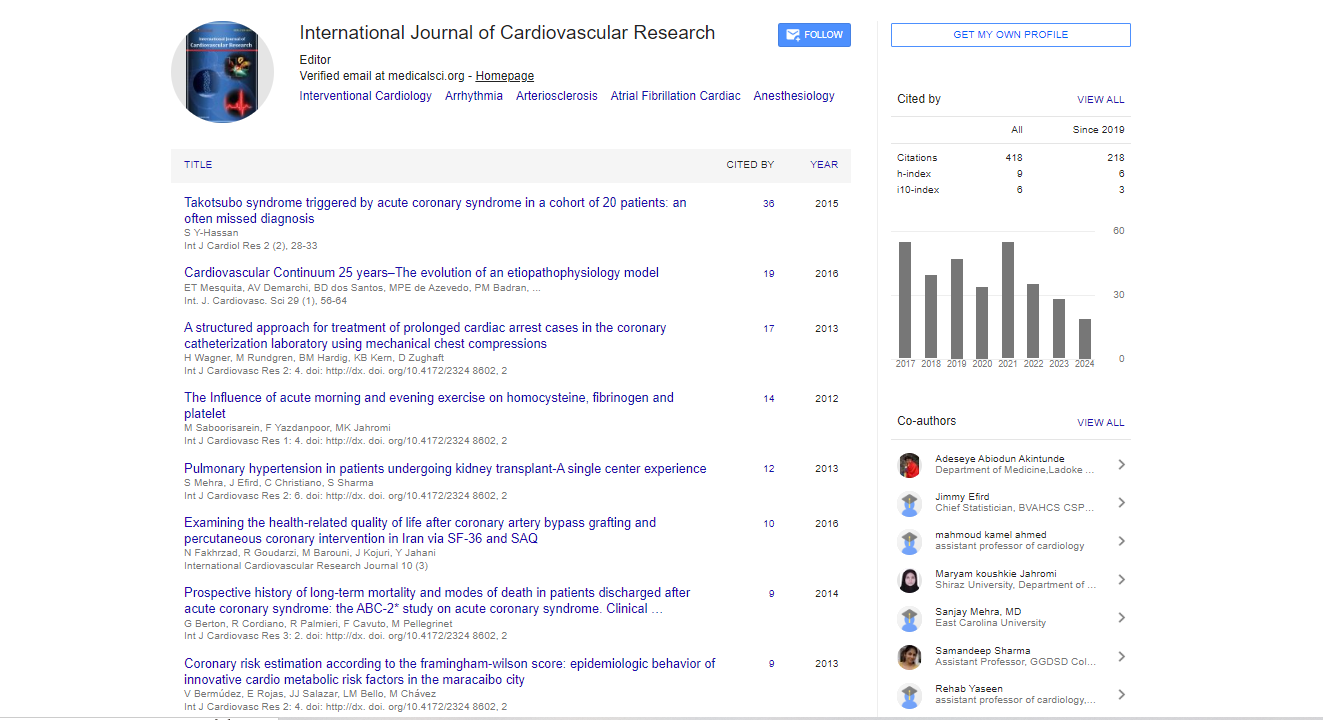Research Article, Int J Cardiovasc Res Vol: 5 Issue: 1
The Effect of Periodontal Therapy on Atherosclerosis in Cardiovascular Disease: Clinical, Biochemical, Microbiological and Experimental Study
| Hassan Yehya Mohammed Alqudaimi1*, Omar Khashaba2, Hamdy Fouad Marzouk3 and Medhat A El-daker4 | |
| 1Oral Medicine and Periodontology, Faculty of Dentistry, Ibb University, Yemen | |
| 2Oral Medicine and Periodontology, Faculty of Dentistry, Mansoura University, Egypt | |
| 3Hematology and Clinical Pathology, Faculty of Medicine, Mansoura University, Egypt | |
| 4Microbiology and Immunology, Faculty of Medicine, Mansoura University, Egypt | |
| Corresponding author : Hassan Yehya Mohammed Alqudaimi Oral Medicine and Periodontology, Faculty of Dentistry, Ibb University, Yemen Tel: 00201091881300 E-mail: alqudaimihassan@yahoo.com |
|
| Received: December 03, 2015 Accepted: February 08, 2016 Published: February 15, 2016 | |
| Citation: Alqudaimi HYM, Khashaba O, Marzouk HF, El-daker MA (2016) The Effect of Periodontal Therapy on Atherosclerosis in Cardiovascular Disease: Clinical, Biochemical, Microbiological and Experimental Study. Int J Cardiovasc Res 5:1. doi:10.4172/2324-8602.1000255 |
Abstract
The Effect of Periodontal Therapy on Atherosclerosis in Cardiovascular Disease: Clinical, Biochemical, Microbiological and Experimental Study
Objective: The goal of the present study is to assess the effect of periodontal therapy on atherosclerotic changes of cardiovascular patients, in terms of lipid profile and microbiological investigation. It is also to assess the impact of oral inoculation and atheroma with the periodontal pathogen Porphyromonas gingivalis on atherogenesis in hypercholesterolemic mice.
Methods: The study comprises of two parts. Part I: a total of thirty subjects with age range 40-65 were selected for this study and these subjects were divided into three groups. Group (I) periodontitis, group (II) periodontitis with cardiovascular disease and group (III) cardiovascular disease. Part II: fifteen mice were divided into two groups. Group (Ι) (study group) with 10 mice and control group (II) included 5 mice. Group (Ι) had undergone high lipid diet and topical application of P. gingivalis bacteria three times a week for one month while the control group received low diet only.
Results: The clinical results of both group (I) and group (II) showed the clinical parameters: popliteal-brachial index (PBI), probing pocket depth (PPD) and clinical attachment level (CAL) were statistically significant difference in clinical parameters after four weeks of treatment. Microbiologically, results of microbial evaluation showed that, P. intermedia and P. gingivalis count decreased significantly after treatment in both group (I) and group (II). Pathologically, results of lipid profile evaluation showed that, TG, LDL, HDL and cholesterol levels decreased significantly after treatment in both group (I) and group (II). Experimental results showed that the total cholesterol level was significantly higher in study group after one month of high lipid diet and topical application of P. gingivalis. In addition, after the heart and aorta were obtained, they were observed for atherosclerotic lesion. The obtained tissue was grinded and cultured on BHI broth aerobically then subculture was done on brain heart infusion agar (Oxoid) supplemented with 5.0 μg/ ml hemin for detection of P. gingivalis. The P. gingivalis was isolated from four atherosclerotic lesions out of ten in the study group while was not detectable in the control group.
Conclusion: Non-surgical periodontal treatment in chronic periodontitis patients could cause significant changes in lipid levels and help in preventing any systemic complications due to the elevated lipid levels. The presence of periodontal bacteria in atheromatous plaques was confirmed by this investigation and, there is correlation between periodontitis bacteria and microorganisms involved in the atherosclerotic lesions.
 Spanish
Spanish  Chinese
Chinese  Russian
Russian  German
German  French
French  Japanese
Japanese  Portuguese
Portuguese  Hindi
Hindi 



